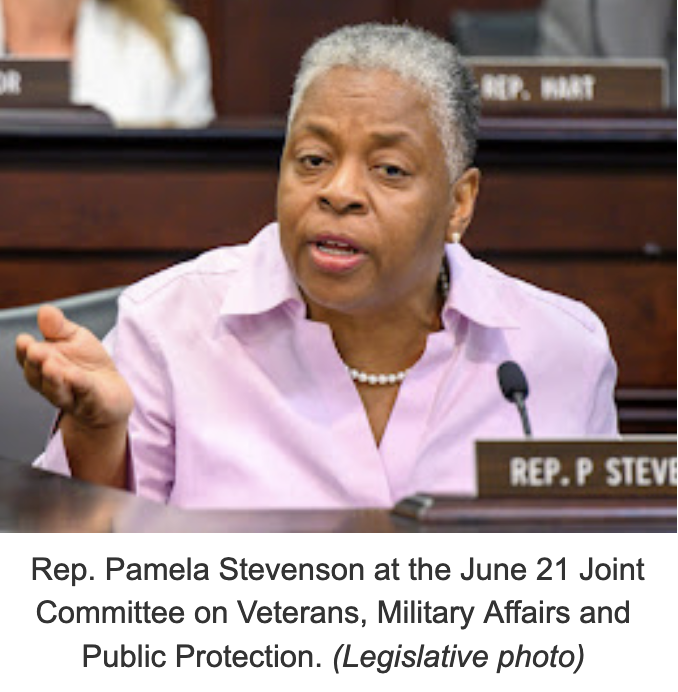By Melissa Patrick
Kentucky Health News
The legislature’s Interim Joint Committee on Veterans, Military Affairs and Public Protection spent over two hours hearing from organizations advocating for resources to prevent veteran suicide at its June 21 meeting.
“We owe these men and women a tremendous debt of gratitude and it is paramount that legislators work to protect and care for Kentucky’s military service members and retirees,” Rep. Walker Thomas, co-chair of the committee, said in a news release.
“According to the U.S. Department of Veterans Affairs, in 2020, 119 of the 6,146 veteran suicides nationwide were Kentucky veterans. In comparing the suicide rate of Kentucky veterans to the suicide rate of all Kentuckians, the difference is staggering—with Kentucky veterans’ rate at 41.3 and Kentucky’s total rate at 22.4,” says the release.
Michael Stoyonovich, with the Kentucky unit of the Disabled American Veterans, asked the lawmakers to consider a bill to prevent veteran suicide that would strengthen and coordinate proven suicide prevention programs and connect more veterans and their families to mental-health services.
Stoyonovich shared statistics from the University of Kentucky College of Public Health: In 2017, 124 Kentucky veterans died by suicide; in 2018, 126; in 2019, 103; in 2020, 125; and in 2021, 111.
Rep. Pamela Stevenson, a Democrat from Louisville who served in the Air Force for 27 years, called on Stoyonovich and the others who spoke to hold the lawmakers accountable.
“We can pass legislation,” she said. ” If we don’t pass this legislation to stop veterans from killing themselves, then all we’ve done is made it a bumper sticker. . . . Everyone here has said they believe in what you said . . . everyone that’s testified. Now it’s time for you to call us and say, ‘Where’s the legislation?’ We’ve proven we could get something done in an hour on the floor. Let’s get this done in an hour on the floor.”
Juan Renaud, the deputy commissioner of the state Department of Veterans Affairs, shared data from Kentucky’s Community Mental Health Centers that shows the need in Kentucky is great. In Fiscal Year 2022, which ended last June 30, the centers served 2,372 veteran and active-duty personnel; 601 of them were active and 1,771 were veterans.
He also told the members that a 2012 study found higher rates of suicidal ideas and behaviors among National Guard members after deployment (31 per 100,000) than among actives (20.2) or reserves (24).
Rep. Steve Bratcher, R-Elizabethtown, who is in the Guard, said one reasons could be that states are relying on Guard members to do so much more than their monthly commitment, especially in Kentucky with its Covid-19 response, riots, tornadoes and flooding. And on top of that, he said they hold regular jobs.
“I don’t think that people realize the challenges that it takes on you personally,” he said. “So that’s why you probably see a difference in the amount of increase in suicides in the National Guard; they do reserve and active duty.”
Retired Brig. Gen. Steven P. Bullard, who works with the Kentucky Commission on Military Affairs, talked about how hard it is to return to the community after serving in the military.
“I went from commanding a combat squadron during Iraqi Freedom to being with my family in Walt Disney World 48 hours later—and it was the single worst experience I ever went through in my entire life, I can’t tell you how terrible it was for me,” he said. “You come back as a guardsman. . . . You’re released back into your community … and you’re not in that cocoon any longer and you’re with people who just don’t understand.”
Matt Castor, vice-president of government and corporate relations with USA Cares, a national organization headquartered in Louisville, said his organization works to remove some of the triggers of veteran suicides, like housing, financial struggles and transitioning into a career and that he, like the other organizations who help veterans, needed more funding.
“Simply put, we need your help,” he said. “We are looking at the highest number of veterans coming to us this year than we’ve ever had in 20 years.”
Castor said when they started the organization 20 years ago they were largely helping veterans with physical injuries from the war in Iraq, but since those needs have changed.
“Over the last 20 years, those needs have transitioned and we deal now with more of the invisible injuries of post-traumatic stress and traumatic brain injury,” he said. “And as we do that, we’ve realized a few things . . . we may not be able to stop a suicide directly but we may be able to eliminate the factors that push somebody to make that type of terrible decision.”
Castor said in 2022 they received 224 applications for assistance, but could only help 15.3% of them due to a lack of funds. He said it cost about $4,000 per family to stop eviction from their home or foreclosure. He also talked about helping veterans with their car payments, noting that this allows them to take care of their families and get to their jobs.
“These are all triggers. These have a direct and profound impact on these families, that if we don’t address these particular issues, then this rate will continue,” he said.
